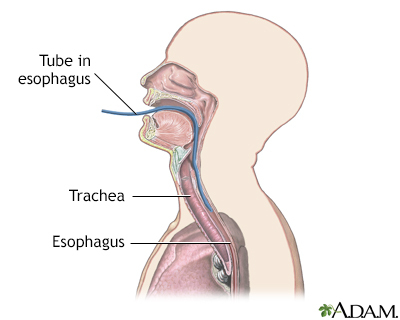Esophageal pH monitoring
Definition
Esophageal pH monitoring is a test that measures how often stomach acid enters the tube that leads from the mouth to the stomach (called the esophagus). The test also measures how long the acid stays there.
Alternative Names
pH monitoring - esophageal; Esophageal acidity test
How the Test is Performed
A thin tube is passed through your nose or mouth to your stomach. The tube is then pulled back into your esophagus. A monitor attached to the tube measures the acid level (pH) in your esophagus.
You will wear the monitor on a strap and record your symptoms and activity over the next 24 hours in a diary. You will return to the hospital the next day and the tube will be removed. The information from the monitor will be compared with your diary notes.
Infants and children may need to stay in the hospital for the esophageal pH monitoring.
A newer method of monitoring esophageal acid (pH monitoring) is by use of a wireless pH probe.
- This capsule-like device is attached to the lining of the upper esophagus with an endoscope.
- It remains in the esophagus where it measures acidity and transmits pH levels to a recording device worn on the wrist.
- The capsule falls off after a 4 to 10 days and moves down through gastrointestinal tract. It is then expelled with a bowel movement and flushed down the toilet.
How to Prepare for the Test
Your health care provider will ask you to not eat or drink after midnight before the test. You should also avoid smoking.
Some medicines may change the test results. Your provider may ask you to not take these for between 24 hours and 2 weeks (or more) before the test. You also may be told to avoid alcohol. Medicines that you may need to stop include:
- Adrenergic blockers
- Antacids
- Anticholinergics
- Cholinergics
- Corticosteroids
- H2 blockers
- Proton pump inhibitors
DO NOT stop taking any medicine unless told to do so by your provider.
How the Test will Feel
You briefly feel like gagging as the tube is passed through your throat.
The Bravo pH monitor causes no discomfort.
Why the Test is Performed
Patient Education Video: Gastroesophageal reflux disease
Esophageal pH monitoring is used to check how much stomach acid is entering the esophagus. It also checks how well the acid is cleared downward into the stomach. It is a test for gastroesophageal reflux disease (GERD).
In infants, this test is also used to check for GERD and other problems related to excessive crying.
Normal Results
Normal value ranges may vary depending on the lab doing the test. Talk to your provider about the meaning of your specific test results.
What Abnormal Results Mean
Increased acid in the esophagus may be related to:
- Barrett esophagus
- Difficulty swallowing (dysphagia)
- Esophageal scarring
- Gastroesophageal reflux disease (GERD)
- Heartburn
- Reflux esophagitis
You may need to have the following tests if your provider suspects esophagitis:
- Barium swallow
- Esophagogastroduodenoscopy (also called upper GI endoscopy)
Risks
Rarely, the following may occur:
- Arrhythmias during insertion of the tube
- Breathing in of vomit if the catheter causes vomiting
Gallery

References
Falk GW, Katzka DA. Diseases of the esophagus In: Goldman L, Schafer AI, eds. Goldman-Cecil Medicine. 26th ed. Philadelphia, PA: Elsevier; 2020:chap 129.
Kavitt RT, Vaezi MF. Diseases of the esophagus.In: Flint PW, Francis HW, Haughey BH, et al, eds. Cummings Otolaryngology: Head and Neck Surgery. 7th ed. Philadelphia, PA: Elsevier; 2021:chap 68.
Richter JE, Vaezi MF. Gastroesophageal reflux disease. In: Feldman M, Friedman LS, Brandt LJ, eds. Sleisenger and Fordtran's Gastrointestinal and Liver Disease. 11th ed. Philadelphia, PA: Elsevier; 2021:chap 46.